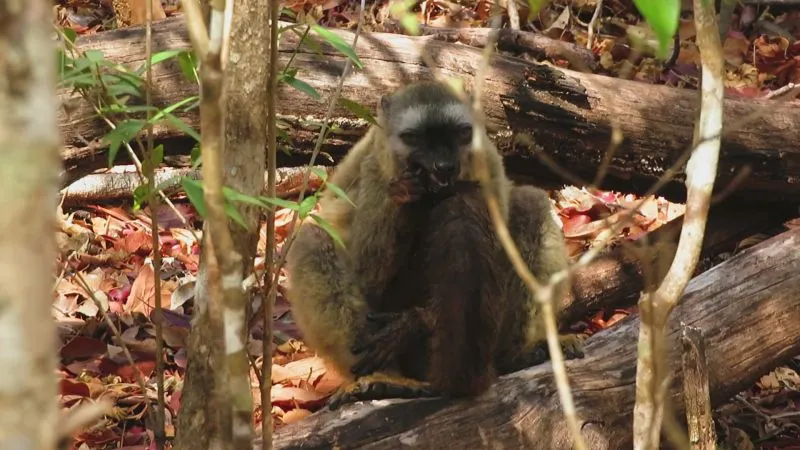Lemurs Smear Bugs on Their Privates to Ward Off Infection
Lathering up with orange goo from millipede guts might relieve infections, expel parasites in lemurs
A few years ago, a group of researchers stumbled upon a female lemur engaging in a bizarre ritual. In her left hand was a millipede, freshly plucked from the forest floor. As the scientists watched, the lemur munched briefly on the millipede’s body, gnawing greedily until it oozed orange—and proceeded to rub the saliva-slicked drippings vigorously over her genitals, anus and tail. After a well-earned break, she concluded the ordeal by gulping down the millipede’s spent body—but this encore act seemed to play second fiddle to her slathering shenanigans.
To better understand this behavior, that same team, led by Louise Peckre, a behavioral ecologist at the German Primate Center at the Leibniz Institute for Primate Research in Germany, monitored two groups of red-fronted lemurs in the Kirindy Forest of Madagascar. In a study published this week in the journal Primates, the researchers found that lemurs in this locale munch on millipedes—but not for snacking purposes, or even grisly necrophilia. Instead, they believe these primates scrub themselves with the masticated carcasses to treat or prevent the spread of gastrointestinal disease—in essence, a form of self-medication.
“It’s not something that has been observed much in lemurs before, but it’s a group [in which] I’d expect to see it happening—they’re very curious and very smart,” says Ian Tattersall, an anthropologist and lemur expert at the American Museum of Natural History who was not involved in the new study.
Smearing smelly stuff on one’s body, or “self-anointing,” is a fairly widespread behavior in primates that was observed first in the 1980s, writes Sophia Daoudi for The Conversation. An individual from a different species of lemur was spotted mid-slather in the 1990s. But the motivations aren’t always clear and self-anointing doesn’t necessarily mean a primate is self-medicating.
To deter hungry predators, millipede bodies brim with toxic chemicals—including a class of substances called benzoquinones. By applying a DIY anointment of drool and millipede juice, primates may be exploiting the medicinal properties of these benzoquinones, which are known to act as an insect repellent. Scientists studying other primate species believe benzoquinones might protect against mosquito-borne diseases like malaria or yellow fever. Even though these same bug-killing chemicals can be toxic for the primates if ingested in high doses, the short-term payoff of forestalling infection is worth the risk.

The self-anointing behavior of these particular lemurs was a bit puzzling, however. Although eau de millipede may be a prized antimalarial in other primate populations, the red-fronted lemurs of Kirindy didn’t seem particularly plagued by insect-borne diseases. Even if they were, insects would be more likely to attack the lemurs’ exposed faces, rather than their furry tails and undersides.
Rather, as Peckre noted, red-fronted lemurs in Madagascar are far more vulnerable to gastrointestinal parasites similar to human pinworms, which can cause troublesome bouts of skin rashes and pruritus ani—an unnecessarily fancy way of saying “itchy butthole.” And upon closer inspection, the researchers noticed that many of the lemurs had bald spots on their lower backs—patches called “sit spots”—telltale signs of frequent itching and rubbing.
Peckre theorized that the lemurs were using the millipedes to kill two birds with one stone. By anointing themselves in these secretions, they were killing pinworms where they were most transmissible—at the anus and tail. In addition, some lemurs were going the extra mile, ingesting the odious chemicals to purge their bodies of residual infection. “Self-anointment combined with eating millipede secretions may be a way of self-medication,” explains Peckre in a statement for the German Primate Center.
Future work is needed to confirm if benzoquinones are actually an effective method of protection against lemur pinworm. Additional research might also test if surges in self-anointing line up with parasite season in these lemurs. In the meantime, it’s worth marveling at these lemurs’ dedication to well-being. As for those that taste their own medicine, it most certainly is bitter.
/https://tf-cmsv2-smithsonianmag-media.s3.amazonaws.com/accounts/headshot/10172852_10152012979290896_320129237_n.jpg)
/https://tf-cmsv2-smithsonianmag-media.s3.amazonaws.com/filer/f4/73/f47305f7-9d6b-434b-ba9b-78521df5fdc3/rotstirnmaki_maennchen.jpg)


/https://tf-cmsv2-smithsonianmag-media.s3.amazonaws.com/accounts/headshot/10172852_10152012979290896_320129237_n.jpg)